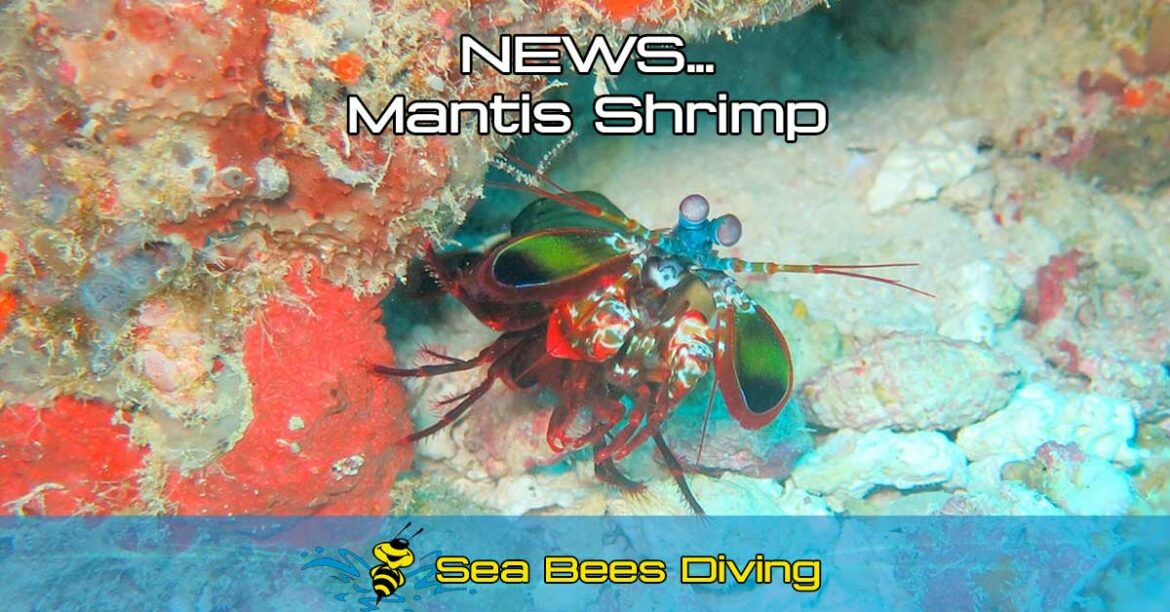Mantis shrimps are mere inches long but can throw the fastest punch of any animal. They strike with the force of a rifle bullet and, with the aid of super-speed cameras, we can truly appreciate how powerful this animal is.
A few years ago, an aggressive creature named Tyson smashed through the quarter-inch-thick glass wall of his cell. He was soon subdued by nervous attendants and moved to a more secure facility in Great Yarmouth, England. Unlike his heavyweight namesake, Tyson was only four inches long. But scientists have recently found that Tyson, like all his kin, can throw one of the fastest and most powerful punches in nature. He is a mantis shrimp.
Mantis shrimps – Relatives of crabs and lobsters
Mantis shrimps are aggressive relatives of crabs and lobsters – they are known as Stomatopods – and they prey upon other animals by crippling them with devastating jabs. Their secret weapons are a pair of hinged arms folded away under their head, which they can unfurl at incredible speeds.
The ‘spearer’ species have arms ending in a fiendish barbed spike that they use to impale soft-bodied prey like fish. But the larger ‘smasher’ species have arms ending in heavy clubs, and use them to deliver blows with the same force as a rifle bullet.
Fastest claw in the west
When Sheila Patek, a researcher at USC Berkeley, tried to study these heavy-hitters on video, she hit a snag. “None of our high speed video systems were fast enough to capture the movement accurately” she explained.
“Luckily, a BBC crew offered to rent us a super high speed camera as part of their series ‘Animal Camera’.” With this cutting-edge equipment, Patek managed to capture footage of a smasher’s strike, slowed down over 800 times. What she found was staggering. With each punch, the club’s edge travels at about 50 mph, over twice as fast as scientists had previously estimated.*
“The strike is one of the fastest limb movements in the animal kingdom”, says Patek. “It’s especially impressive considering the substantial drag imposed by water.”
Water is much denser than air and even the quickest martial artist would have considerable difficulty punching in it. And yet the mantis shrimp’s finishes its strike in under three thousandths of a second, out-punching even its land-living namesake.
The need for speed
If the animal simply flicked its arm out, like a human, it would never achieve such blistering speeds. Instead, mantis shrimps use an ingeniously simple energy storage system. Once the arm is cocked, a ratchet locks it firmly in place. The large muscles in the upper arm then contract and build up energy. When the latch is released, all this energy is released at once and the lower arm is launched forwards.
But Patek found that even this system couldn’t account for the mantis shrimp’s speed. Instead, the key to the punch is a small, structure in the arm that looks like a saddle or a Pringle chip.
When the arm is cocked, this structure is compressed and acts like a spring, storing up even more energy. When the latch is released, the spring expands and provides extra push for the club, helping to accelerate it at up to 10,000 times the force of gravity.
This smasher’s arm is truly state-of-the-art natural technology. “Saddle-shaped springs are well-known to engineers and architects”, explains Patek, “ but is unusual in biological systems. Interestingly, a recent paper showed that a similarly shaped spring closes the Venus’s fly trap.”
Killing with bubbles
Patek’s cameras revealed an even bigger surprise – each of the smasher’s strikes produced small flashes of light upon impact. They are emitted because the club moves so quickly that it lowers the pressure of the water in front of it, causing it to boil.
This releases small bubbles which collapse when the water pressure normalises, unleashing tremendous amounts of energy. This process, called cavitation, is so destructive that it can pit the stainless steel of boat propellers. Combined with the force of the strike itself, no animal in the seas stands a chance.
Large smashers can even make meals of crabs, buckling their thick armour as easily as they do aquarium glass. And they are often seen beating up much larger fish and octopi, which are unfortunate enough to wander past their burrows.
Not just a good right hook
Some scientists think that the mantis shrimps’ belligerent nature evolved because the rock crevices they inhabit are fiercely contested. This competition has also made these animals smarter than the average shrimp. They are the only invertebrates that can recognise other individuals of their species and can remember the outcome of a fight against a rival for up to a month.
Quite impressive, we think!
Interested in diving with a mantis shrimp? You can find them on many dive sites around Phuket & the Similans islands.
Just keep your eyes wide open!


